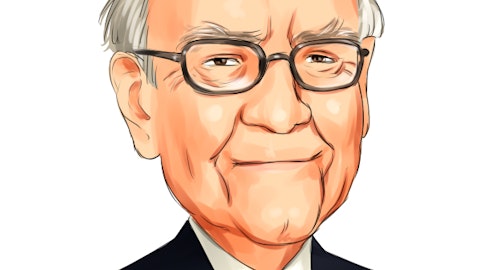![]() Warren Buffett explained the difference between value and price when he said “Long ago, Ben Graham taught me that ‘Price is what you pay; value is what you get.’ Whether we’re talking about socks or stocks, I like buying quality merchandise when it is marked down.”
Warren Buffett explained the difference between value and price when he said “Long ago, Ben Graham taught me that ‘Price is what you pay; value is what you get.’ Whether we’re talking about socks or stocks, I like buying quality merchandise when it is marked down.”
While value and price are different, individual investors often need to consider both concepts. Apple Inc. (NASDAQ:AAPL) might offer value with a low price-to-earnings (P/E) ratio, but the stock’s price is near $500 and individual investors might not be able to build a diversified portfolio if they pay that much for a single stock.

There is a strategy that generates immediate income while setting up possible buys of high-priced stocks when they pull back to a good value.
To find value, I look at the PEG ratio. I believe this indicator is the best way to determine which stocks are truly undervalued. To find the PEG ratio, you divide the P/E ratio by the earnings growth rate. A stock is considered to be trading at fair value when the PEG ratio is 1.
Many investors look at P/E ratios and consider low P/E stocks to be buys. This approach ignores the growth rate of earnings. If a company is growing earnings at 40% a year, the stock should be worth more than the stock of a company growing earnings at 10% a year. If both companies are trading with a P/E ratio of 15, the PEG ratio says that the fast-growing company is undervalued and the slow-growing company is overvalued.
In this example, the PEG ratio for the first company is 0.38 (15/40) and the second company’s PEG ratio is 1.5 (15/10). In order to reach fair value where the PEG ratios are 1, we would expect the first stock to rise and the second one to fall.
There are other factors you should consider when valuing a stock, but PEG ratios are extraordinarily useful and simple to apply. They allow us to develop price targets that can then be used to determine attractive buy prices for stocks.
For example, AAPL is expected to earn $39.34 per share in 2013 and deliver long-term earnings growth averaging 15% a year. To find a price target, we can multiply $39.34 by 15, which gives us $590. At that price, the PEG ratio would be 1 because the P/E ratio would be 15 and equal to the earnings growth rate of 15%.
AAPL is currently trading near $500 and could be about 18% undervalued at this level. This stock would be a buy now, or you can wait for a pullback. Waiting for a pullback helps increase the size of the potential gain assuming the price target is accurate.
Better yet, instead of simply waiting for a pullback, you could use a put selling strategy, which commits you to buying the stock if it falls below a certain price.
AAPL might be more attractive to you at $400 a share. You could sell a put option on AAPL with a $400 strike price that expires in January 2015 for about $25. If AAPL is below $400 when the option expires, you will buy it at $400, but the $25 a share you received when selling the put will reduce the actual price to only $375.
Just be sure that you understand the risk. If AAPL falls below the strike price, you will be obligated to purchase 100 shares per option sold at $400, costing you $40,000, less the $2,500 received for selling the put, or $37,500. Some traders prefer to set aside the full amount needed to cover this obligation, and your broker will likely require you to deposit a percentage of that obligation in your account, called a “margin requirement.”
This strategy can be applied to any stock, although it works particularly well with high-priced stocks that you would like to own. The premiums received when selling a put on stocks like AAPL, Google Inc (NASDAQ:GOOG) or Priceline.com Inc (NASDAQ:PCLN) can be substantial. That income could help you grow wealth while waiting for value to develop in companies you want to own.
Markets determine price, but the PEG ratio can be used to determine value. High-priced stocks might actually be bargains, like AAPL seems to be, and a put selling strategy can reduce the cost of owning any stock.
Consider selling puts on stocks that you find attractive to generate income and ensure you buy them during a pullback.
This article was originally written by Amber Hestla and posted on ProfitableTrading.
$1,000 Per Month Trading System
You could collect $1,000 or more per month without buying a single stock. Click here to learn how…




